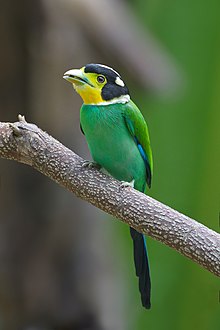| Long-tailed broadbill | |
|---|---|

| |
| Scientific classification | |
| Domain: | Eukaryota |
| Kingdom: | Animalia |
| Phylum: | Chordata |
| Class: | Aves |
| Order: | Passeriformes |
| Family: | Eurylaimidae |
| Genus: | Psarisomus Swainson, 1837 |
| Species: | P. dalhousiae
|
| Binomial name | |
| Psarisomus dalhousiae (Jameson, 1835)
| |
The long-tailed broadbill (Psarisomus dalhousiae) is a species of bird that is found in the Himalayas, extending east through Northeastern India to Southeast Asia. It is the only bird in the genus Psarisomus.[2] The long-tailed broadbill is about 25 cm (10 inches) in length and weighs between 50 and 60 grams. It can be identified by its shrill call.
The long-tailed broadbill displays a yellow plumage on the throat. Blueish-green plumage on the belly, back, and wings. The long-tailed broadbill is a forest bird that lives on insects. It is very sociable and normally travels in large, noisy parties except during the mating season. It builds a pear-shaped nest in a tree. The female usually lays between 5 and 6 eggs that are incubated by both sexes; both sexes also help to feed the young.
- ^ BirdLife International (2016). "Psarisomus dalhousiae". IUCN Red List of Threatened Species. 2016: e.T22698747A93701800. doi:10.2305/IUCN.UK.2016-3.RLTS.T22698747A93701800.en. Retrieved 11 November 2021.
- ^ Gill, Frank; Donsker, David; Rasmussen, Pamela, eds. (2023). "NZ wrens, Sapayoa, asities, broadbills, pittas". World Bird List Version 13.1. International Ornithologists' Union. Retrieved 6 June 2023.
